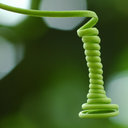Floral elaiophore structure in four representatives of the Ornithocephalus clade (Orchidaceae: Oncidiinae).
کلید واژه ها
خلاصه
OBJECTIVE
A significant number of species assigned to the Neotropical orchid sub-tribe Oncidiinae reward insect pollinators with oil produced in floral glands termed elaiophores. The latter may be glabrous (epithelial elaiophores) or hirsute (trichomal elaiophores). Although the detailed anatomy and ultrastructure of epithelial elaiophores have been studied for a number of genera, such as Oncidium Sw., Gomesa R. Br. and Trichocentrum Poepp. & Endl., hitherto, trichomal elaiophores have been investigated only for a single species of Oncidiinae, Ornithocephalus ciliatus Lindl. Furthermore, this is the only representative of the Ornithocephalus clade to be investigated to date. Here, an examination is made of the elaiophore anatomy and ultrastructure of a further four species currently assigned to this clade (Ornithocephalus gladiatus Hook., Phymatidium falcifolium Lindl., Zygostates grandiflora (Lindl.) Mansf. and Zygostates lunata Lindl.) and the results compared with those obtained for other Oncidiinae.
METHODS
Elaiophore structure was examined for all species at three stages of flower development: closed bud, first day of anthesis and final stage of anthesis, using light microscopy, fluorescence microscopy, scanning electron microscopy, transmission electron microscopy and histochemistry.
RESULTS
Elaiophores of O. gladiatus occur upon the lateral lobes of the labellum and display characters intermediate between those of typical epithelial and trichomal elaiophores, in that they are largely glabrous, consisting mainly of cuboidal epidermal cells, but bear short, unicellular hairs proximally. By contrast, the elaiophores of all the other species investigated occur on the callus and are of the trichomal type. In P. falcifolium, these unicellular hairs are capitate. In all species, oil secretion commenced at the closed floral bud stage. Ultrastructurally, the mainly trichomal elaiophores of the four representatives of the Ornithocephalus clade closely resembled the epithelial elaiophores of other Oncidiinae, in that their cells displayed an organelle complement typical of lipid-secreting cells. However, in some taxa, a number of noteworthy characters were present. For example, the elaiophore cuticle of O. gladiatus and P. falcifolium was bi-layered, the outer layer being lamellate, the inner reticulate. The cuticle of Z. grandiflora and Z. lunata was also lamellate, but here, a reticulate layer was absent. Accumulation of secreted oil resulted in the localized distension of the cuticle. Cuticular cracks and pores, however, were absent from all species. The walls of the secretory cells of Z. grandiflora were also atypical in that they had short protuberances or ingrowths, and contained cavities which are thought to be involved in the secretory process.
CONCLUSIONS
Of the species investigated, most displayed similar anatomical organization, their trichomal elaiophores occurring on the labellar callus. They, thus, differ from many other members of the Oncidiinae, where epithelial elaiophores are found either on the callus, or on the lateral lobes of the labellum. However, ultrastructurally, all elaiophores, whether those of representatives of the Ornithocephalus clade, or those of other oil-secreting Oncidiinae, possessed a similar complement of organelles, regardless of whether the elaiophores were trichomal or epithelial. In view of the latter, and the similar chemical composition of oils derived from all Oncidiinae investigated to date, it is probable that position and type of elaiophore, and possibly the structure of the overlying cuticle, play an important role in pollinator selection in these oil-secreting orchids.


